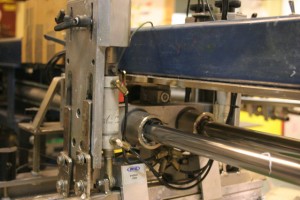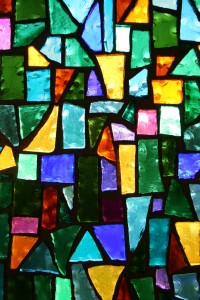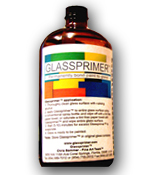Glass printing options
Traditional printing processes rely on liquid ink. The paper (or other media) absorbs the ink. Glass isn’t absorbent, so glass printing is a challenge. Traditional inks and paints don’t work well, leaving few viable options for printing on glass.
Glass printing techniques
Silk screening. The traditional, tested method of glass printing is silk screening. The technique creates an image that’s clearly visible from a distance. Close inspection reveals that the image is made from millions of tiny dots. Depending upon the size of the screen, silk screen printing can offer coverage off varying percentages. The standard screen provides 60% coverage.
Silk screen printing was invented more than 100 years ago, and involves placing ink on the surface of the glass through a mesh screen. Once the ink has been applied to the glass, the glass and ink are fired to allow the ink to adhere firmly to the glass. Images with multiple colors require a different screen for each color, and the glass must be fired each time a new color is added to the image. The process is time-consuming and is prone to registration and coloration errors.
A related technique is screen transfer printing, where the image is transferred from paper to the glass. As with silk screening, screen printed transfers must be fired once they’ve been applied to the glass in order to permanently bond the image to the glass, and multiple screens may be required to form a single image.
Digital ceramic ink printing. Digital ceramic ink is applied using a flatbed inkjet printer. The ink is precisely controlled and dries on contact with the glass. This allows the printer to eliminate unwanted color blending, and provide precise control over the thickness of individual paint droplets. Once the paint is applied, it’s fired to create permanent adhesion with the glass surface.
UV Inkjet glass printing. UV inkjet glass printing represented an evolution in glass printing techniques. An earlier glass printing technique bonded an image printed on a clear substrate to the glass. UV inkjet glass printing uses an inkjet printer to deposit UV-curable ink directly on glass. Prior to the application of ink, the glass surface is treated with a special primer, like Glassprimer™ glass surface molecular activator. Once the primer and ink have been applied, the ink is exposed to UV light and permanently bonded to the glass. A similar technique uses heat-curable inks that are baked after being applied to glass. The advantage of UV-curing is that it is virtually instant and does not require firing.
If you’d like more information about Glassprimer™ glass surface molecular activator, for use with UV-inkjet glass printing, please check out the rest of our site. If you’d like to purchase Glassprimer™ glass surface molecular activator, please visit our online store .
Photo Credit: Mads Buddig, via FreeImages.com



